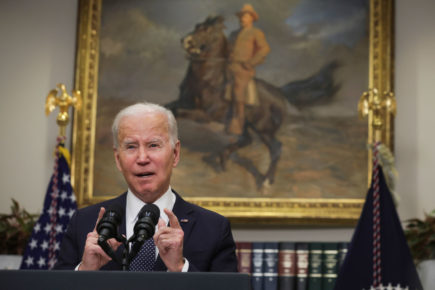In good times or bad, American presidents come to Congress with a diagnosis that hardly differs over the decades. In their State of the Union speeches, they declare “the state of our union is strong,” or words very much like it.
President Joe Biden’s fellow Americans, though, have other ideas about the state they’re in and little hope his State of the Union address Tuesday night can turn anything around.
America’s strength is being sharply tested from within — and now from afar — as fate, overnight, made Biden a wartime president in someone else’s conflict, leading the West’s response to a Russian operation in Ukraine that makes all the other problems worse.
The state of the union is disunity and division. It’s a state of exhaustion from the pandemic. It’s about feeling gouged at the grocery store and gas pump. It’s so low that some Americans, including prominent ones, are exalting Russian President Vladimir Putin.
Measures of happiness have hit a bottom, with fewer Americans saying they are very happy in the 2021 General Social Survey than ever before in five decades of asking them.
Biden will step up to the House speaker’s rostrum to address a nation in conflict with itself. The country is litigating how to keep kids safe and what to teach them, weary over orders to wear masks, bruised over an ignominious end to one war, in Afghanistan, and suddenly plenty worried about Ukraine. A speech designed to discuss the commonweal will be delivered to a nation that is having increasing difficulty finding much of anything in common.
Even now, a large segment of the country still clings to the belief that the last election was stolen.
Four decades ago, President Jimmy Carter confronted a national “crisis of confidence” in a speech describing a national malaise without using that word. But Vice President Kamala Harris did when she told an interviewer last month “there is a level of malaise” in this country.
Today’s national psyche is one of fatigue and frustration — synonyms for the malaise of the 1970s. But the divides run deeper and solutions may be more elusive than the energy crisis, inflation and sense of drift of that time.
Take today’s climate of discourse. It’s “so cold,” said Rachel Hoopes, a charity executive in Des Moines, Iowa, who voted for Biden. “It’s hard to see how him talking to us can break through when so many people can’t talk to each other.”
It’s as if Americans need group therapy more than a set-piece speech to Congress.
“We have to feel good about ourselves before we can move forward,” historian Doris Kearns Goodwin told Stephen Colbert on “The Late Show.”
Biden, in his speech, will highlight the improvements from a year ago — particularly on COVID and the economy — but also acknowledge that the job is not yet done, in recognition of the fact that many Americans don’t believe it.
A year into Biden’s presidency, polling indeed finds that he faces a critical and pessimistic public. Only 29% of Americans think the nation is on the right track, according to the February poll from The Associated Press-NORC Center for Public Affairs Research.
In December’s AP-NORC poll, most said economic conditions are poor and inflation has hit them on food and gas. After two years of a pandemic that has killed more than 920,000 in the U.S., majorities put masks back on and avoided travel and crowds in January in the sweep of the omicron variant. Now, finally, a sustained drop in infections appears to be underway.
Most Americans are vaccinated against COVID-19, but debates over masks and mandates have torn apart communities and families.
With Biden so hemmed in by hardened politics, it’s difficult to imagine a single speech altering the public’s perception, said Julia Helm, 52, a Republican county auditor from the suburbs west of Des Moines.
“He’s got a lot of stuff on his plate,” she said. “You know what could change how people feel? And pretty fast? What they pay at the pump. I hate to say it. But gas prices really are the barometer.”
Biden suggested last summer that high inflation was a temporary inconvenience. But it’s snowballed in recent months to a defining challenge of his presidency, alongside, now, the threat of geopolitical instability from Russia’s attack on its neighbor.
Consumer prices over the past 12 months jumped 7.5%, the highest since 1982, as many pay raises were swallowed up and dreams of home ownership or even a used car became prohibitively expensive.
Inflation was a side effect of an economy running hot after the economically devastating first chapters of the pandemic, when Biden achieved the kind of growth that Presidents Barack Obama and Trump could not deliver.
The prime engine for both the gains and the inflation appears to be Biden’s $1.9 trillion coronavirus relief package, which pushed down the unemployment rate to a healthy 4% while boosting economic growth to 5.7% last year — the best performance since 1984.
Still, voters have largely overlooked those gains as inflation bit. The February AP-NORC poll found that more people disapproved than approved of how Biden is handling his job as president, 55% to 44%.
That was a reversal from early in his presidency. As recently as July 2020, about 60% said they approved of Biden in AP-NORC polls.
 صراط عشق صراط عشق
صراط عشق صراط عشق




